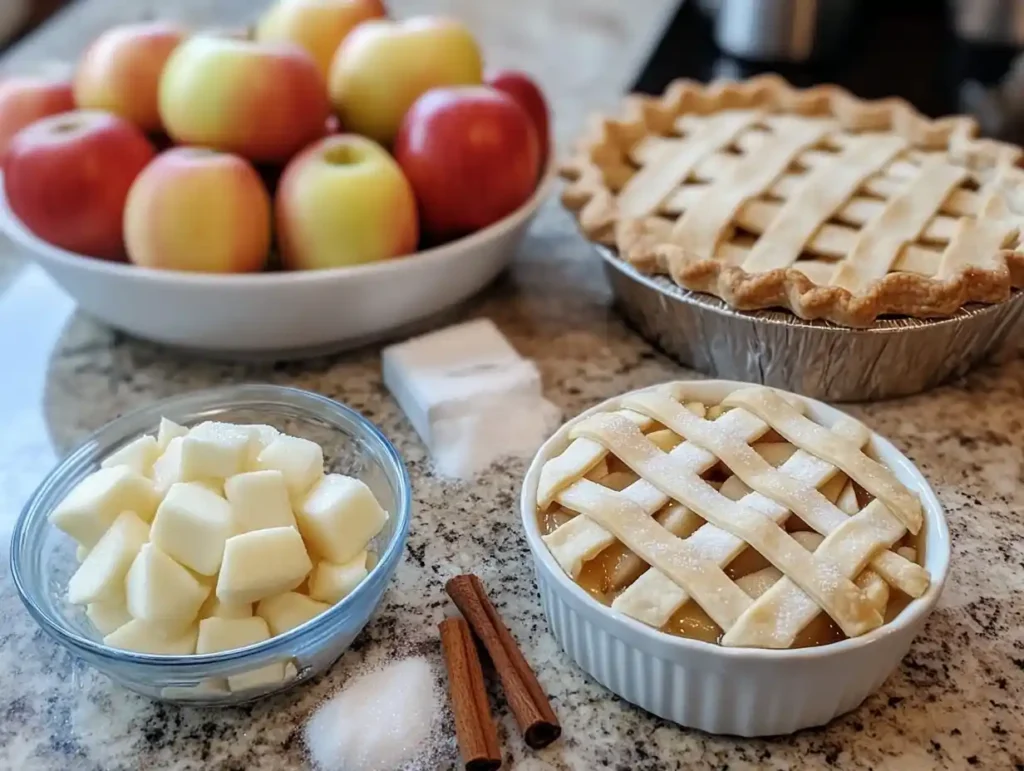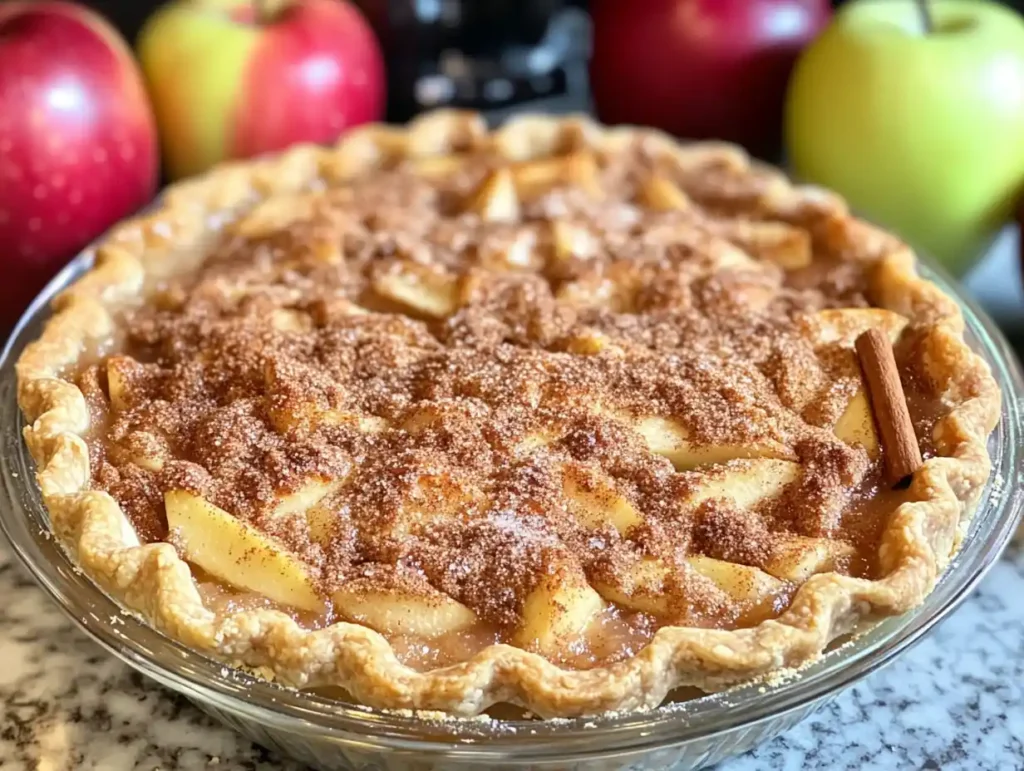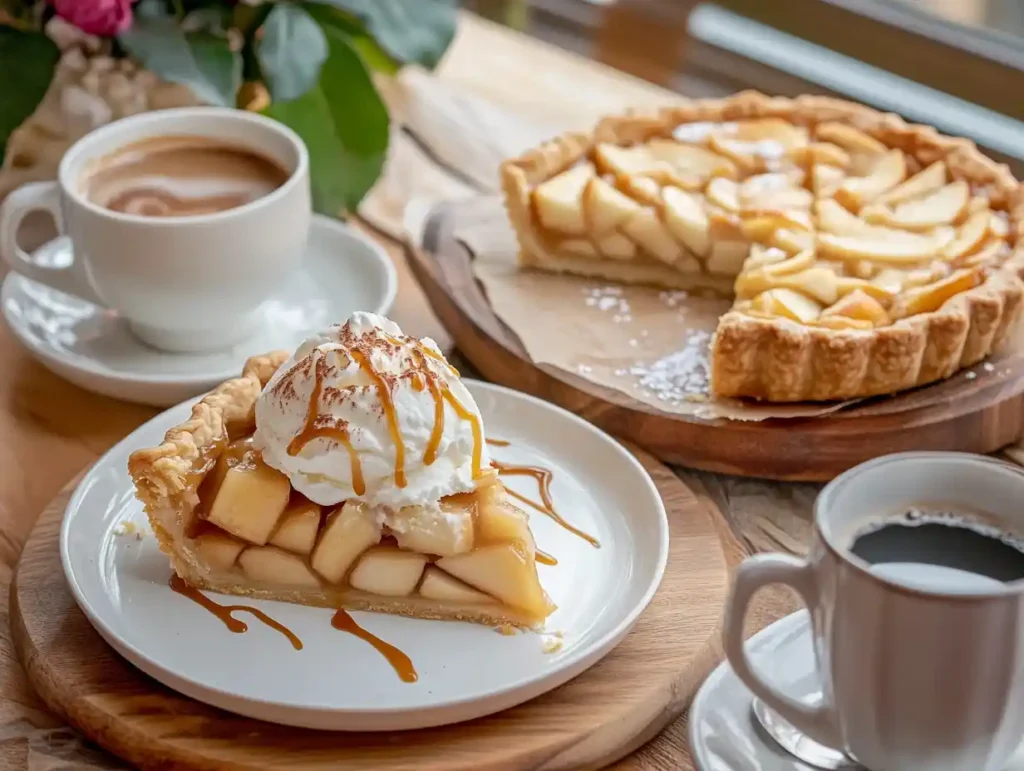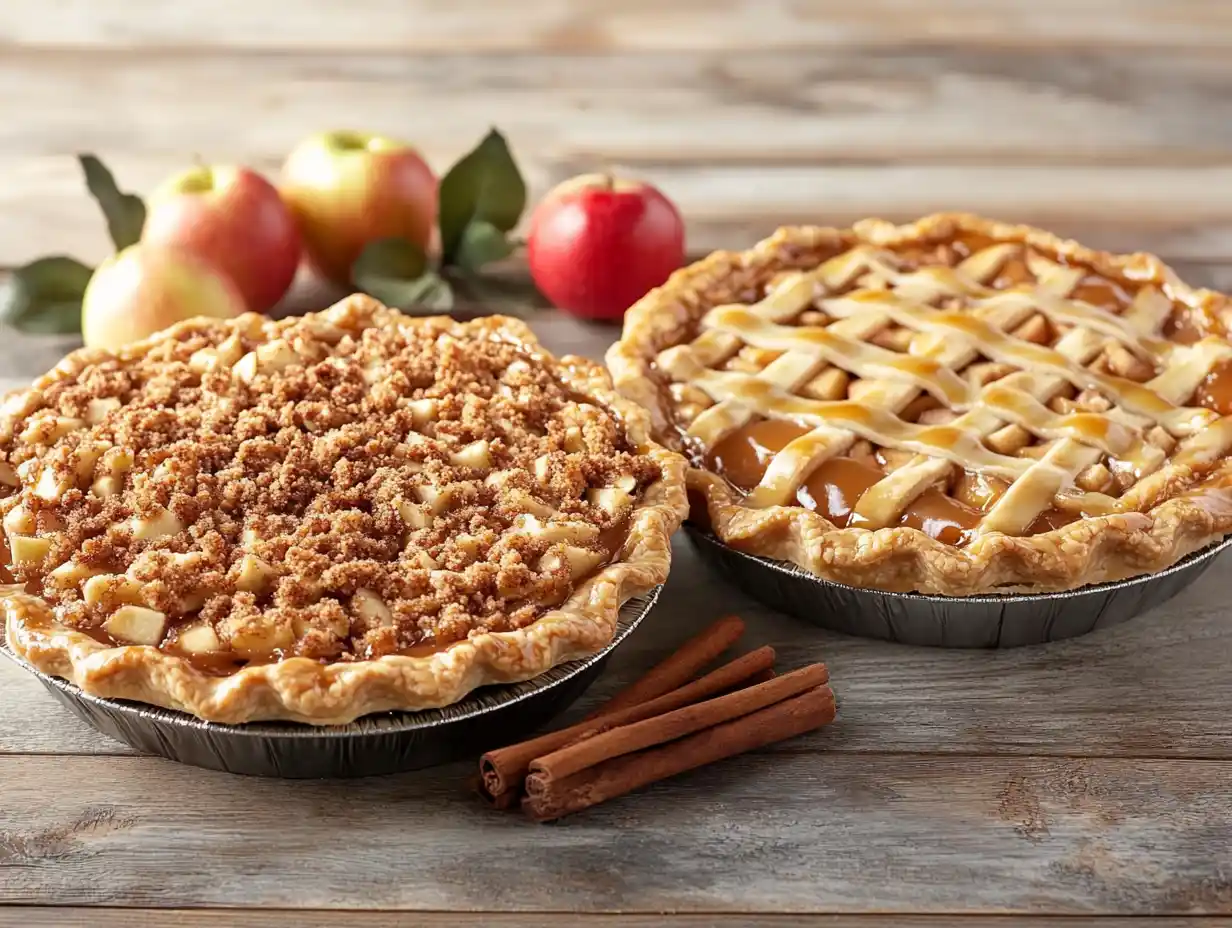Apple pie is one of the most beloved desserts worldwide, but did you know there’s more than one version of this classic treat? Two of the most popular variations are traditional apple pie and Dutch apple pie. While both are packed with sweet, spiced apple filling, their differences often spark curiosity among food lovers.
If you’ve ever wondered, “What’s the difference between apple pie and Dutch apple?” you’re not alone! The key differences lie in their crusts, toppings, and baking methods, which result in distinct flavors and textures.
In this article, we’ll break down the characteristics of each pie, explore their unique features, compare their flavors, and provide tips for baking them at home. By the end, you’ll know exactly which pie is perfect for your next gathering or cozy night in.
Table of Contents
What is an Apple Pie?
Traditional Apple Pie Features

Apple pie is a timeless dessert that has become a symbol of comfort food. Known for its flaky double crust, this pie encases a delicious apple filling that’s sweetened with sugar, cinnamon, and a hint of nutmeg.
- Crust: Traditional apple pie features a double-crust design—one crust at the bottom and another layer covering the filling. The top crust may be solid or styled in a lattice pattern.
- Filling: Typically, apple slices are tossed with sugar, cinnamon, and spices to create a rich, warm flavor.
- Texture: The baked crust is flaky, while the apples inside are tender and juicy.
- Aroma: The combination of cinnamon and baked apples fills kitchens with a delightful smell.
Variations of Apple Pie
Though the classic apple pie is the most popular, it has inspired several variations:
- Lattice Apple Pie – A decorative pie with woven strips of dough on top.
- Caramel Apple Pie – Features caramel sauce mixed into the filling for added sweetness.
- Deep-Dish Apple Pie – Made with a thicker crust and larger slices of apple for extra indulgence.
- Mini Apple Pies – Individual-sized servings, perfect for parties or portion control.
Each variation offers a slight twist to the classic apple pie while maintaining the key ingredients that make it irresistible.
What is a Dutch Apple Pie?

Dutch Apple Pie Characteristics
Dutch apple pie, often referred to as apple crumble pie, stands out due to its streusel topping instead of a traditional crust. This topping creates a crumbly, buttery texture that pairs perfectly with the sweet apple filling.
- Topping: Instead of a second crust, it has a crumbly streusel topping made with flour, butter, sugar, and sometimes oats or nuts.
- Filling: The apple filling is similar to traditional apple pie but sometimes includes raisins or a drizzle of caramel for extra flavor.
- Texture: The streusel creates a crunchy contrast to the soft apple filling below.
- Appearance: It often has a golden, rustic look with scattered crumbs instead of a smooth crust.
Unique Topping – The Crumbly Streusel
The streusel topping is what truly sets a Dutch apple pie apart. Made by combining:
- Flour – Adds structure to the crumbs.
- Butter – Provides richness and binds the mixture.
- Brown Sugar – Adds sweetness and a hint of molasses flavor.
Some recipes also incorporate oats, cinnamon, or chopped nuts to enhance texture and flavor.
Baking Techniques for Apple Pies
Classic Apple Pie Baking Methods
Baking a traditional apple pie requires careful preparation to achieve the perfect flaky crust and juicy filling. Here’s how it’s done:
- Prepare the Dough:
- Use cold butter or shortening to create a flaky texture.
- Chill the dough before rolling it out to prevent shrinking during baking.
- Make the Filling:
- Toss thinly sliced apples with sugar, cinnamon, nutmeg, and lemon juice to enhance flavor and prevent browning.
- Let the mixture sit for 15–20 minutes to allow the juices to release, preventing a soggy crust.
- Assemble the Pie:
- Roll out the bottom crust and place it in the pie pan. Add the apple filling, leaving a slight mound in the center.
- Cover with a top crust, either solid or lattice-style, and seal the edges.
- Bake the Pie:
- Preheat the oven to 425°F (220°C) for a crisp crust.
- Brush the top crust with egg wash for a golden color.
- Bake for 45–55 minutes, covering the edges with foil if they brown too quickly.
Dutch Apple Pie Baking Methods
Dutch apple pie has a slightly different baking process due to its crumbly streusel topping.
- Prepare the Base:
- Use the same method as traditional apple pie for making the crust, but only line the bottom of the pie pan—no top crust is needed.
- Make the Streusel Topping:
- Combine flour, brown sugar, cinnamon, and melted butter until the mixture resembles coarse crumbs.
- Fill and Top the Pie:
- Add the prepared apple filling to the crust and evenly spread the streusel topping over it.
- Bake the Pie:
- Bake at 375°F (190°C) for 45–50 minutes until the topping is golden and crisp.
- If the topping starts to brown too quickly, cover it loosely with foil.
Nutritional Differences
Calorie and Sugar Content
The nutritional profiles of traditional and Dutch apple pies vary, mainly because of the crust and topping.
- Traditional Apple Pie (per slice):
- Calories: Around 320–400 kcal
- Sugar: Approximately 25–30 grams
- Fat: 15–18 grams due to the buttery crust.
- Dutch Apple Pie (per slice):
- Calories: Around 350–450 kcal
- Sugar: Approximately 30–35 grams
- Fat: 18–22 grams, slightly higher due to the streusel topping.
Portion Sizes
Since Dutch apple pie tends to have a richer topping, smaller portions may be more satisfying. On the other hand, traditional apple pie’s lighter crust often encourages larger servings.
- Apple Pie: Perfect for those who prefer a balanced dessert with moderate sweetness.
- Dutch Apple Pie: Better suited for those who enjoy a sweeter, more indulgent treat.
Popular Pairings and Serving Suggestions

Apple Pie Pairings
Traditional apple pie is often served warm and pairs beautifully with a variety of accompaniments. Some popular pairings include:
- Vanilla Ice Cream: The creamy texture and subtle sweetness of vanilla ice cream create a perfect balance with the spiced apples.
- Whipped Cream: Light and airy, whipped cream adds a touch of elegance without overpowering the flavor.
- Cheddar Cheese: A slice of sharp cheddar melted on top offers a surprising savory twist, especially in Southern-style recipes.
- Caramel Sauce: Drizzling warm caramel sauce enhances the sweetness and adds a luxurious finish.
- Hot Beverages: Pair apple pie with coffee, tea, or spiced cider for a cozy treat.
Dutch Apple Pie Pairings
Dutch apple pie, with its crumbly streusel topping, has a slightly sweeter and richer flavor profile, making it ideal for pairing with:
- Caramel Drizzle: A caramel glaze highlights the brown sugar in the topping.
- Cinnamon Whipped Cream: Flavored whipped cream complements the spices and enhances the autumnal feel.
- Espresso or Cappuccino: The strong flavors of coffee balance out the pie’s sweetness.
- Nutty Toppings: Sprinkle chopped pecans or walnuts for added crunch and flavor.
- Vanilla Custard Sauce: Pouring a light custard sauce over the pie creates a creamy, decadent experience.
Both pies work wonderfully with festive drinks, including hot chocolate, mulled wine, or even a glass of dessert wine for a formal gathering.
Which One is Easier to Make?
Preparation Time
- Apple Pie: Preparing and rolling out a double crust can be time-consuming, especially for beginners. The lattice design, if used, also takes extra effort. Expect a total preparation and baking time of 1.5 to 2 hours.
- Dutch Apple Pie: Without the need for a top crust, Dutch apple pie is generally quicker to assemble. Making the streusel topping is straightforward, cutting the total preparation and baking time to about 1 to 1.5 hours.
Skill Level Required
- Apple Pie: Requires more skill to achieve a flaky, golden crust and assemble decorative lattice patterns. Beginners may find this challenging without practice.
- Dutch Apple Pie: Easier for beginner bakers since the crumb topping doesn’t require rolling or shaping. It’s a great option for anyone short on time or baking experience.
FAQs About Apple Pie and Dutch Apple Pie
1. Is Dutch apple pie sweeter than regular apple pie?
Yes, Dutch apple pie is generally sweeter than traditional apple pie. The streusel topping made of brown sugar, butter, and flour adds a caramelized sweetness that contrasts with the fruitiness of the apples. In contrast, a regular apple pie relies more on the natural sweetness of the apples, with less sugar added to the crust.
2. Can I substitute crumb topping for crust in an apple pie?
Absolutely! If you love the flavor and texture of a crumb topping, you can transform a regular apple pie into a Dutch-style pie by replacing the top crust with a streusel topping. Simply sprinkle the crumb mixture over the filling before baking, and you’ll achieve the signature crumbly finish of a Dutch apple pie.
3. Which pie is better for holidays?
Both pies are perfect for holidays, but the choice depends on preference and occasion:
- Traditional Apple Pie is ideal for formal dinners and Thanksgiving gatherings, offering a classic, elegant presentation.
- The Dutch is better for casual parties and potlucks, providing a rustic and comforting feel.
If you want to impress guests, serve both and let them pick their favorite!
4. Can I make either pie gluten-free?
Yes, both pies can be made gluten-free with simple substitutions:
- For the crust, use a gluten-free flour blend or almond flour.
- For the streusel topping in the Dutch, swap all-purpose flour for oat flour or a gluten-free baking mix.
Always check that other ingredients, like oats and baking powder, are labeled gluten-free to avoid cross-contamination.
5. Do both pies taste good when served cold?
Yes, both pies can be enjoyed cold, although many prefer them warm:
- Apple Pie: Tastes delicious chilled, especially with a scoop of ice cream or whipped cream.
- The Dutch : Tastes best slightly warm or at room temperature, as this keeps the streusel topping crisp.
If you prefer serving them warm, you can always reheat slices in the oven for 5–10 minutes at 300°F (150°C).
6. Which pie stays fresher for longer?
Both pies can last for 2–3 days at room temperature when stored in an airtight container. Refrigeration extends their freshness to about 4–5 days.
- Apple Pie: Stays moist because of the sealed crust, which helps retain the filling’s juices.
- Dutch Apple Pie: Tends to dry out more quickly due to the crumbly topping, so it’s best eaten within 2–3 days for optimal flavor and texture.
Conclusion
In the great debate between apple pie and Dutch apple pie, the choice ultimately depends on personal taste and occasion. Both pies celebrate the deliciousness of baked apples, but their differences in crust, topping, and texture set them apart.
If you’re looking for a classic dessert with a flaky double crust, the traditional apple pie is the way to go. Its timeless appeal makes it perfect for holiday dinners and formal celebrations. On the other hand, if you prefer a sweeter, crunchier topping, the Dutch apple pie with its streusel layer is ideal for casual gatherings and quick treats.
Whether you’re a beginner baker or a seasoned pro, both pies are manageable to make at home, and they pair wonderfully with ice cream, coffee, and caramel sauces.
So, next time you’re planning dessert, why not try both and let your guests decide which one wins the flavor showdown? After all, you can never go wrong with apple pie—in any form!
To further explore the nuances of apple pie variations, you might find our article on French vs. Regular Apple Pie: Key Differences insightful. Additionally, our recipe for Mini Pancakes offers a delightful twist on a breakfast classic. For a savory option, consider trying our Sourdough Garlic Bread.

